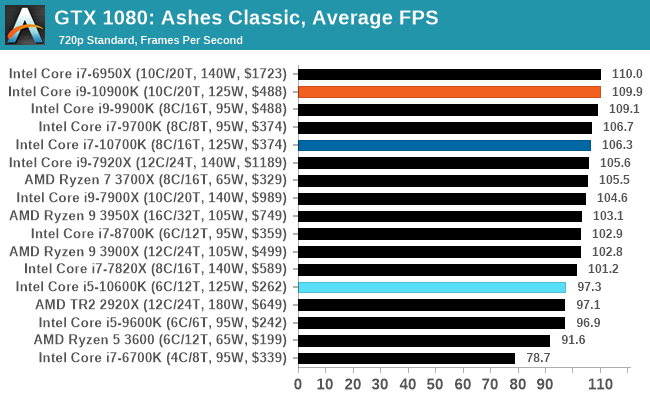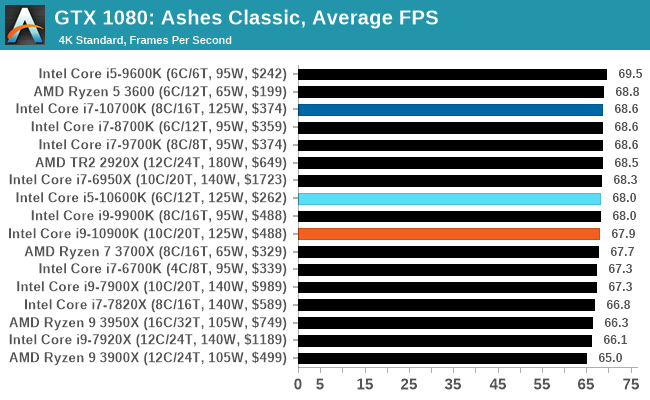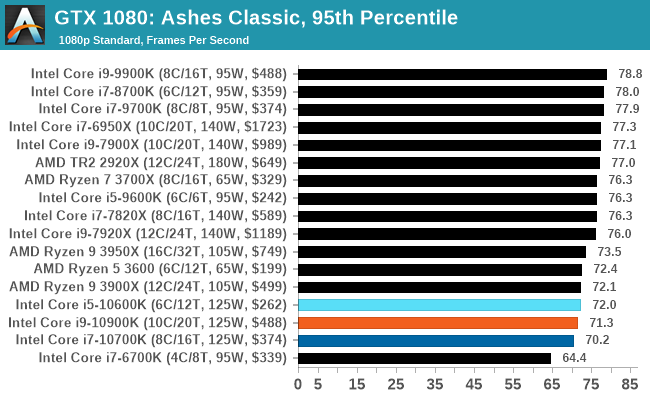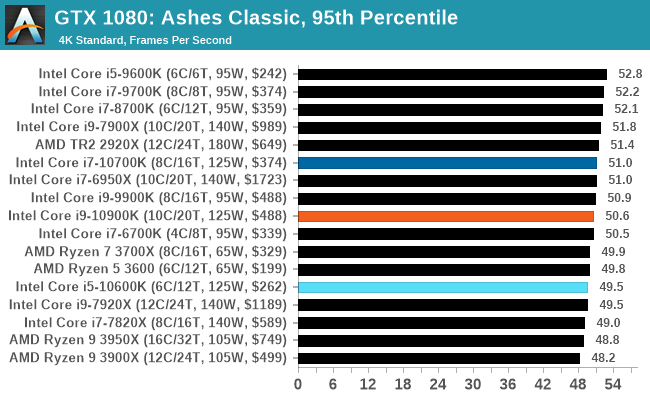The Intel Comet Lake Core i9-10900K, i7-10700K, i5-10600K CPU Review: Skylake We Go Again
by Dr. Ian Cutress on May 20, 2020 9:00 AM EST- Posted in
- CPUs
- Intel
- Skylake
- 14nm
- Z490
- 10th Gen Core
- Comet Lake
Gaming: Ashes Classic (DX12)
Seen as the holy child of DirectX12, Ashes of the Singularity (AoTS, or just Ashes) has been the first title to actively go explore as many of the DirectX12 features as it possibly can. Stardock, the developer behind the Nitrous engine which powers the game, has ensured that the real-time strategy title takes advantage of multiple cores and multiple graphics cards, in as many configurations as possible.
As a real-time strategy title, Ashes is all about responsiveness during both wide open shots but also concentrated battles. With DirectX12 at the helm, the ability to implement more draw calls per second allows the engine to work with substantial unit depth and effects that other RTS titles had to rely on combined draw calls to achieve, making some combined unit structures ultimately very rigid.
Stardock clearly understand the importance of an in-game benchmark, ensuring that such a tool was available and capable from day one, especially with all the additional DX12 features used and being able to characterize how they affected the title for the developer was important. The in-game benchmark performs a four minute fixed seed battle environment with a variety of shots, and outputs a vast amount of data to analyze.
For our benchmark, we run Ashes Classic: an older version of the game before the Escalation update. The reason for this is that this is easier to automate, without a splash screen, but still has a strong visual fidelity to test.
Ashes has dropdown options for MSAA, Light Quality, Object Quality, Shading Samples, Shadow Quality, Textures, and separate options for the terrain. There are several presents, from Very Low to Extreme: we run our benchmarks at the above settings, and take the frame-time output for our average and percentile numbers.
All of our benchmark results can also be found in our benchmark engine, Bench.

| AnandTech | IGP | Low | Medium | High |
| Average FPS |  |
 |
 |
 |
| 95th Percentile |  |
 |
 |
 |











220 Comments
View All Comments
UltraWide - Wednesday, May 20, 2020 - link
Intel's 10th gen is a hard pass for me.I'll wait patiently with my 4770K.
Spunjji - Tuesday, May 26, 2020 - link
Haswell was the last time I remember being excited about an Intel CPU.AnarchoPrimitiv - Wednesday, May 20, 2020 - link
Why is the article stating that the 10900k is "around the same price" as the 3900x when its literally around $100 more (3900x currently goes for $417 and the 10900k has listed at $522, $488 is only the tray price when you buy 1000 or more CPUs)? In my opinion a 25% more expensive CPU isn't "around the same price"dirkdigles - Wednesday, May 20, 2020 - link
Same thoughts - I commented on that earlier. Quite misleading IMO.drothgery - Wednesday, May 20, 2020 - link
comparing retail prices of something just released vs something that's been out for months is silly, so they went by MSRP (which for CPUs is the tray price)?GreenReaper - Wednesday, May 20, 2020 - link
Don't see how that works. You buy based on the performance available now, that is what the charts are based on - so why not the price now?duploxxx - Wednesday, May 20, 2020 - link
perhaps a reviews site should start testing with the defaults…. so put a default cooler on this system and test again in a case and heating next to it and see how much is reall left from this marketing turbo and theoretical benchmarking....jameslr - Wednesday, May 20, 2020 - link
What's a "default cooler"? None of these CPUs come with a "cooler" or HSF unit.GreenReaper - Wednesday, May 20, 2020 - link
So test it anyway, see what happens when you don't include a vital bit of kit in the comparison price.Spunjji - Tuesday, May 26, 2020 - link
The AMD ones do. They could throw in a known-equivalent cooler on the Intel side and repeat a few of the tests with it to see how it fares - one of those $30 Coolermaster jobs should do the trick.At least that way you'd get an idea of the extremes - "properly" cooled with a water loop vs. cooled the way most people used to do home builds.